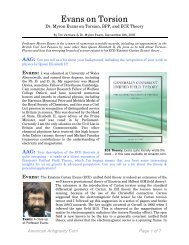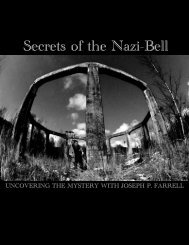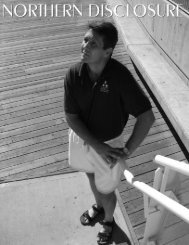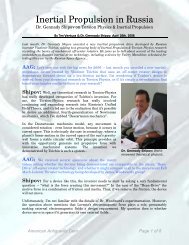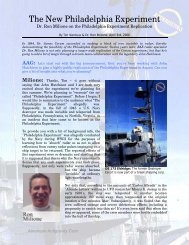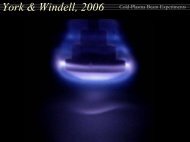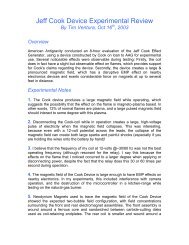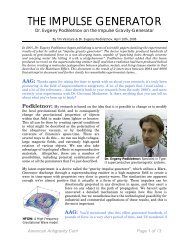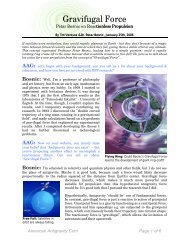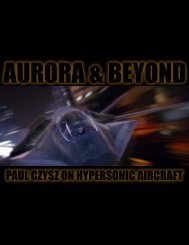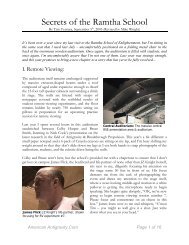The Nazi Bell - American Antigravity
The Nazi Bell - American Antigravity
The Nazi Bell - American Antigravity
Create successful ePaper yourself
Turn your PDF publications into a flip-book with our unique Google optimized e-Paper software.
Electrical Engineer Jack Casazza has provided an excellent history on Kron’s life, which can<br />
be summarized in the following quote: “He was thrown out of the University of Michigan<br />
because he was always fighting with the instructors, at something like sixteen. He<br />
decided to work his way around the world, and came to Hollywood. He was very<br />
brilliant. He had so many problems because his professors were a couple of light years<br />
behind him. He got back to Hollywood, signed a contract for $10,000 or so to work on<br />
his new experimental movie camera, and the company that gave him the contract paid<br />
him the money up front and went bankrupt. So he had a year or two with no work to do.<br />
He came to New York City. In the public library he started to read books on mathematics<br />
and became the inventor of something called tensor analysis. It became quite important<br />
but then he worked for GE. He was unusual and was not easy to work with because he<br />
was ahead of his time. You have to mention him in the history of electrical engineering<br />
because he was a character....”<br />
John Dering has also commented on Gabriel Kron, stating, “Kron provides -- if nothing else -- the<br />
experimental verification of Einstein’s Unified Field. Kron shows that certain anomalies in synchronous<br />
machines can not be accounted for by any physical description except the Unified Field equations.” It makes<br />
sense that both Dering and Corum support Kron’s research, as they had the opportunity to<br />
compare notes on this research while they worked together at SARA, Inc in 1997. Corum<br />
has since gone on to work as the Chief Scientist at the Institute of Scientific Research in<br />
Kentucky.<br />
Gabriel Kron: Scientist<br />
and Electrical Engineer.<br />
What makes Kron’s work so valuable in analyzing the<br />
Philadelphia Experiment is that Kron developed a method of<br />
tensor analysis for use in practical electrical engineering – a<br />
method that could be rigorously applied to electrical systems<br />
on a practical level that could be used by engineers. In fact,<br />
Kron even went a step further – in the analysis of complex<br />
synchronous electrical systems, he postulated that the only<br />
method by which some of them could be explained was<br />
through the use of Einstein’s Unified Field <strong>The</strong>ory, which<br />
suggests that the elements for the Philadelphia Experiment<br />
and perhaps even <strong>Nazi</strong> <strong>Bell</strong> technology are lie dormant at<br />
some level in even common household electrical equipment.<br />
This connection between Kron’s work and Einstein’s Unified Field <strong>The</strong>ory forms the basis<br />
for a real connection between the degaussing coils that Tesla presumably modified for use<br />
on the USS Eldridge and the reported mysterious effects that occurred during the<br />
experiment. “<strong>The</strong> scientists on the Philadelphia Experiment would have also been<br />
familiar with Gabriel Kron’s work,” says Corum, “It had been around since the 1920’s,<br />
and had been taught in GE’s advanced engineering school, as it has a variety of<br />
applications to solving problems that occur across multiply-connected electrical systems,<br />
such as the North <strong>American</strong> power-grid.”<br />
Through Kron’s work, Corum is able to describe vacuum-manifold manipulation of spacetime,<br />
but more importantly, to provide some insight into how it can be engineered for future<br />
applications, including potentially <strong>Antigravity</strong> and space flight. When reached for comment<br />
<strong>American</strong> <strong>Antigravity</strong>.Com Page 13 of 17



